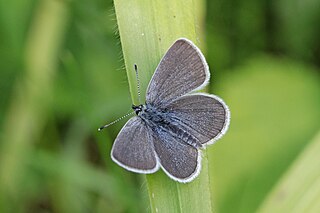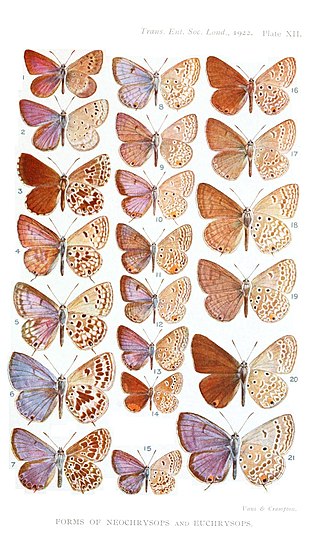
The large blue is a species of butterfly in the family Lycaenidae. The species was first defined in 1758 and first recorded in Britain in 1795. In 1979 the species became mostly extinct in Britain but has been successfully reintroduced with new conservation methods. The species is classified as "near threatened" on the IUCN Red List of Threatened Species. Today P. arion can be found in Europe, the Caucasus, Armenia, western Siberia, Altai, north-western Kazakhstan and Sichuan.

The Karner blue is an endangered species of small blue butterfly found in some Great Lakes states, small areas of New Jersey, the Capital District region of New York, and southern New Hampshire in the United States. The butterfly, whose life cycle depends on the wild blue lupine flower, was classified as an endangered species in the United States in 1992.

The small blue is a Palearctic butterfly in the family Lycaenidae. Despite its common name, it is not particularly blue. The male has some bluish suffusion at the base of its upper wings but is mostly dark brown like the female. The species can live in colonies of up to several hundred and in its caterpillar stage is cannibalistic.

The silver-studded blue is a butterfly in the family Lycaenidae. It has bright blue wings rimmed in black with white edges and silver spots on its hindwings, lending it the name of the silver-studded blue. P. argus can be found across Europe and east across the Palearctic, but it is most often studied in the United Kingdom where the species has experienced a severe decline in population due to habitat loss and fragmentation.

Phengaris alcon, the Alcon blue or Alcon large blue, is a butterfly of the family Lycaenidae and is found in Europe and across the Palearctic to Siberia and Mongolia.

The Senegal lapwing or lesser black-winged lapwing is a species of bird in the family Charadriidae. It is found in Angola, Burundi, Cameroon, Republic of the Congo, Democratic Republic of the Congo, Ivory Coast, Eswatini, Gabon, Gambia, Ghana, Guinea, Kenya, Liberia, Malawi, Mali, Mozambique, Nigeria, Rwanda, Senegal, Sierra Leone, Somalia, South Africa, Tanzania, Togo, Uganda, Zambia, and Zimbabwe. It lives primarily in open grassy habitats.
Lepidochrysops pephredo, the Estcourt blue, is a species of butterfly in the family Lycaenidae. It is endemic to South Africa, and is found in the grassy hills of the KwaZulu-Natal midlands.

Orachrysops niobe, the Brenton blue, is a species of butterfly in the family Lycaenidae and is endemic to South Africa.
Chrysoritis pelion, the Machacha opal, is a butterfly of the family Lycaenidae found only in South Africa. Terblanche and van Hamburg state "due to their intricate life histories and the unique wing patterns and colouring the butterflies of the genus Chrysoritis are of significant conservation and aesthetic value".

Anthene amarah, the black-striped hairtail, leaden hairtail or leaden ciliate blue, is a butterfly of the family Lycaenidae. It is found in tropical Africa and Arabia. The habitat consists of savanna and occasionally open areas in the forest zone.
Lepidochrysops ignota, the Zulu blue, is a butterfly of the family Lycaenidae. It is found in South Africa, from the KwaZulu-Natal midlands to Eswatini, Mpumalanga, Limpopo and Gauteng.

Orachrysops lacrimosa, the restless blue, is a butterfly of the family Lycaenidae. It is found in South Africa, where it is known from the KwaZulu-Natal midlands to the eastern part of the Free State and Mpumalanga.
Orachrysops subravus, the grizzled blue, is a butterfly of the family Lycaenidae. It is found in South Africa, where it is known from montane grassland from the Eastern Cape to the southern Drakensberg foothills and the KwaZulu-Natal midlands.
Orachrysops regalis, the royal blue, is a butterfly of the family Lycaenidae. It is found in South Africa, where it is known from Mpumalanga to the Strydpoortberge and Letsitele Kop.
Orachrysops violescens, the violescent blue, is a butterfly of the family Lycaenidae. It is found in South Africa, where it is known from Mpumalanga to the Limpopo province and in the southern part of the Kruger National Park.
Orachrysops mijburghi, the Mijburgh's blue, is a butterfly of the family Lycaenidae. It is found in South Africa, where it is known from highland grassveld in the Free State.
Orachrysops montanus, the Golden Gate blue, is a butterfly of the family Lycaenidae. It is found in South Africa, where it is known from montane grassland in the Golden Gate Highlands.
Orachrysops nasutus, the nosy blue, is a butterfly of the family Lycaenidae. It is found in South Africa.
Orachrysops warreni, the Warren's blue, is a butterfly of the family Lycaenidae. It is found in South Africa, where it is only known from one hillside in the Verloren Valei in Mpumalanga.








